As an Amazon Associate I earn from qualifying purchases. Please read the disclaimer for more info.
As you wander through the vibrant streets of Hue, Vietnam, the alluring aromas of local cuisine are quick to greet you. Hue has a distinguished culinary tradition steeped in history, owing much to its imperial past. Typical Hue dishes are known for their balance of flavor and delicate presentation, reflecting the sophistication that once graced the tables of Vietnamese royalty.
Hue food is famed for its variety and complexity, with an emphasis on aesthetics and the harmony of yin and yang in each dish. You’ll notice that the food here often has a slight edge in spiciness compared to other regions of Vietnam — a testament to the royal penchant for more flamboyant flavors.
Each dish tells a story of cultural influence and regional bounty, from the staple rice cakes like ‘banh beo’ to the heartwarming ‘bun bo Hue,’ a spicy beef noodle soup that has earned its reputation well beyond the borders of Vietnam.
This central Vietnamese cuisine is also about the community. Street food stalls and humble restaurants invite you to sit down and enjoy the local hospitality as much as the food itself. Sharing a ‘banh khoai,’ a kind of crispy pancake, over banter with the locals might just become the highlight of your Hue experience.
Hue food is a journey through taste, tradition, and the warmth of human connection, leaving your palate and your heart full. Enjoy this Hue food guide.
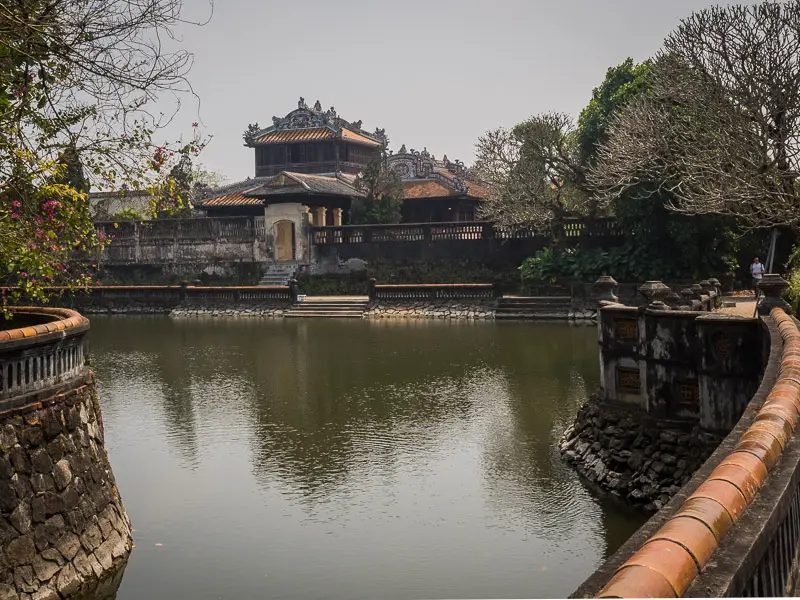
Historical Significance of Hue Cuisine
You’re about to discover how Hue’s rich history has shaped its unique culinary profile.
Influence of Nguyen Dynasty
Under the Nguyen Dynasty, Hue became the seat of Vietnamese royal power, and yes, the kitchen got busy. Your taste buds might tingle knowing they brought a whole entourage of culinary innovation.
Hue was the imperial capital, so chefs needed to impress. They meticulously crafted dishes fit for kings and queens. Think of banh beo, tiny steamed rice cakes topped with savory ingredients — simplicity and sophistication on a leaf.
Hue’s Imperial Cuisine Legacy
Walking through Hue’s food stalls, you’ll notice a legacy of complexity and refinement in the dishes. The dynasty’s cooks had to get creative to please the palates of the emperors, hence the birth of imperial cuisine.
It’s not just food; it’s art. Banh khoai, for example, is more than just a pancake; it’s a delicate balance of shrimp, pork, bean sprouts, and sauce wrapped in a crispy golden shell — each bite a silent nod to its royal past.
Short on time? Join this popular Hue Cyclo Night Food Tour to sample popular Hue foods
Iconic Dishes of Hue
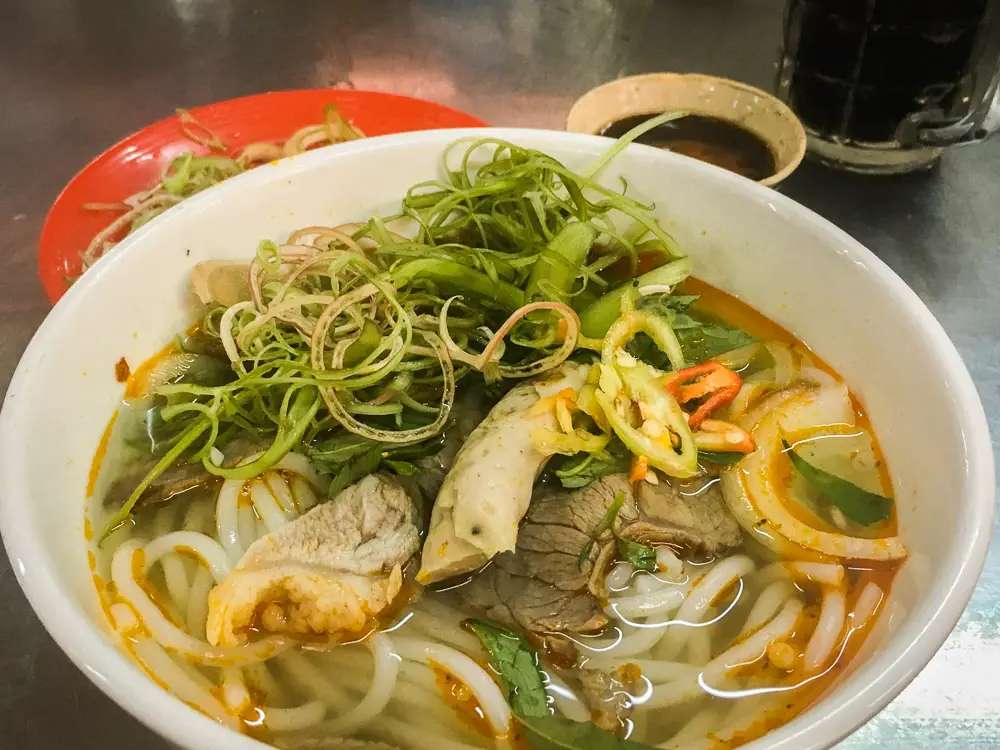
When you wander through the streets of Hue, prepare to embark on a culinary adventure with dishes that hold a royal heritage. Each bite carries the tradition and soul of the former imperial capital.
Soups and Noodles
Hue is renowned for its variety of soups and noodles, each bursting with distinctive flavors. Bun bo Hue (Hue beef noodle soup) is a standout, with its balance of spicy, savory, and umami from the beef broth, lemongrass, and fermented shrimp paste with rice noodles, tender slices of beef, congealed pig’s blood, and pork knuckles.
The rich soup is topped with a combination of cilantro sprigs, diced green onions, complete the dish, banana blossom, and served with lime and chili on the table.
It is the most famous Hue food.
Another favorite is bun hen, a less-known sibling of bun bo Hue, combining rice vermicelli with baby clams.
Bun Thit Nuong is a delightful dish that beautifully represents the culinary culture of Hue. Translated as ‘grilled meat with noodles,’ Bun Thit Nuong features tender pieces of marinated grilled pork served atop a bed of white rice vermicelli (bun) and garnished with fresh herbs, pickled vegetables, and a generous topping of crushed peanuts.
Bun Thit Nuong is typically served with a side of ‘nuoc cham,’ a tangy fish sauce-based dipping sauce that’s a staple in Vietnamese cuisine. In Hue, you might find the nuoc cham to be spicier and richer, reflecting the city’s love for bold flavors.
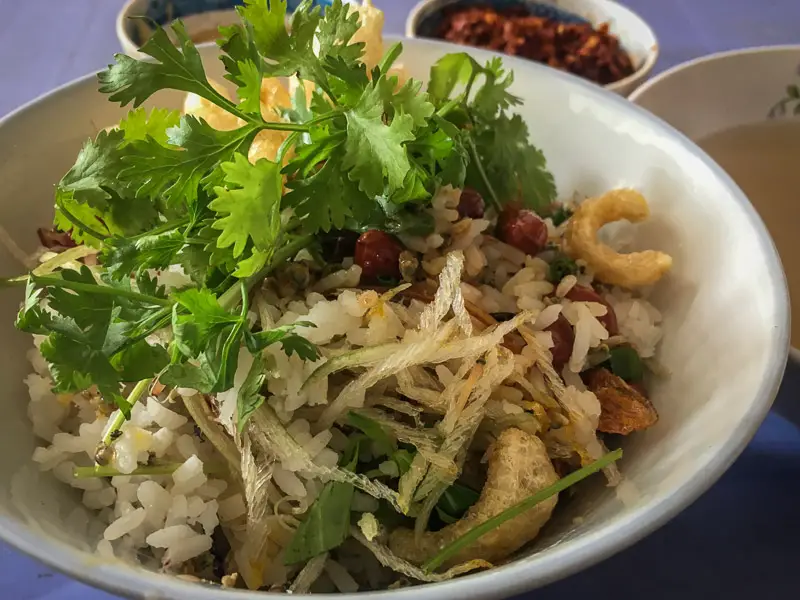
Rice-Based Specialties
Com hen (Clam Rice) is a unique treat. You’ll find a medley of rice, stir-fried clams, roasted peanuts, and crispy pork skin tied together with a flavorful clam broth. The dish tells a story of resourcefulness, turning simple ingredients into a filling meal. It is a popular Vietnamese breakfast dish.
Com Hen is also similar to clam rice dish Hen Ron in Hoi An.
Savory Pancakes and Dumplings
You can’t miss out on Hue’s crispy banh khoai and the variety of dumplings like banh beo, banh nam, and banh bot loc. These bite-sized treats, packed with shrimp, pork, and traditional fish sauce, are not just food but a cultural insight.
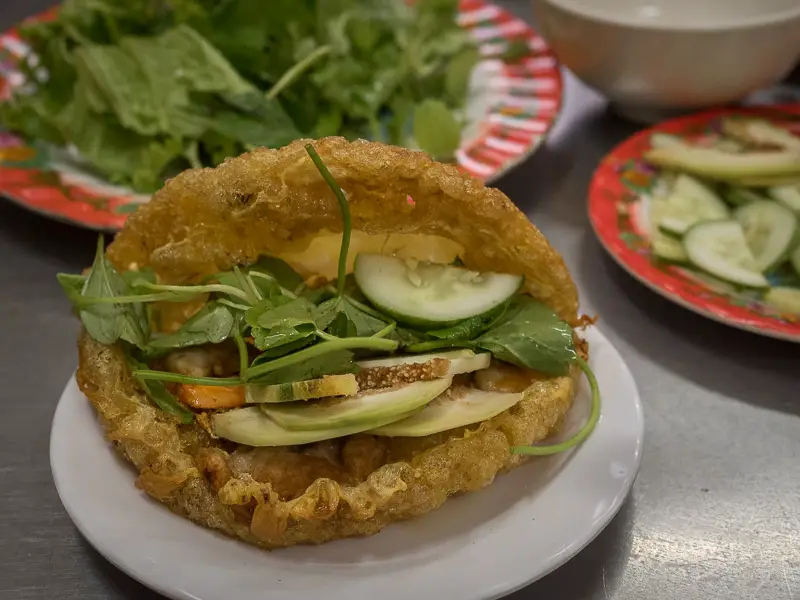
- Banh khoai – A crispy pancake filled with shrimp and pork belly, best enjoyed with fresh herbs and a special dipping sauce.
- Bánh bèo (Water Fern Cakes) – Small steamed rice cakes topped with savory toppings such as shrimp and crispy pork skin.
- Banh It Ram (or Banh Ram It) are fried sticky rice dumplings crispy made with crispy rice crackers topped with a steamed sticky rice dumpling that includes a mixture of pork and shrimp. The thick rice cracker is what sets the dish apart from some other local dishes that are soft and chewy in nature, just like Banh Nam.
Enjoy these treasures and feel the connection to Hue with every delight.
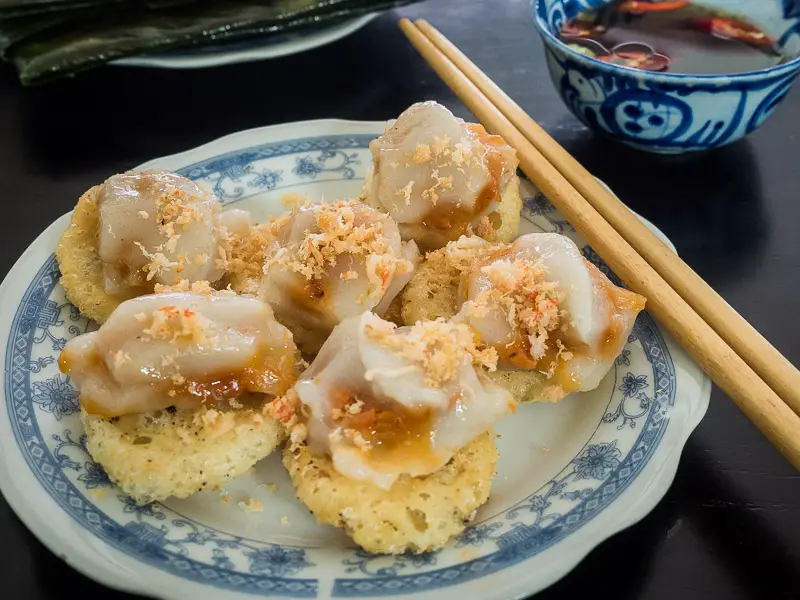
Food Resources: 11 Best Vietnamese Cookbooks to Add to Your Asian Inspired Kitchen
Traditional Snacks and Sweets
When you wander through Hue, it’s impossible to miss the allure of its traditional street food and variety of sweets, each telling its own story of cultural heritage.
Street Food Delights
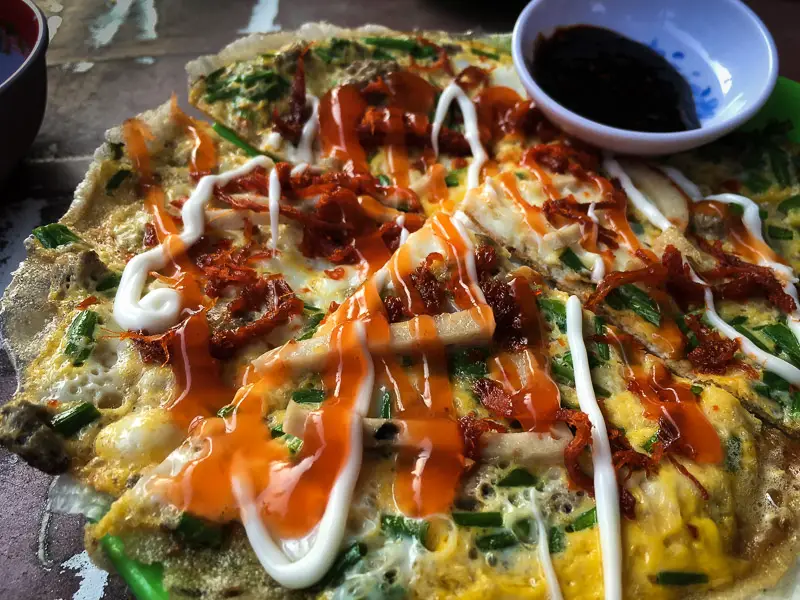
One bite of Banh Trang Trung, often referred to as Vietnamese pizza, and a staple street food of Dalat and you’ve got a festival of flavors on your palate. It’s a must-try made with rice paper grilled over coal, topped with egg, and other toppings like shrimp or pork.
Then there’s the Banh Loc – translucent dumplings filled with shrimp and pork, wrapped in banana leaves, a humble yet satisfying treat.
If you fancy something a little heartier, the Banh Uot comes into play. These are silky flat rice noodles, typically served with a variety of meats, herbs, and dipping sauces. A great way to fill up and fuel the rest of your exploration.
For a crisper experience, Banh Xeo is your go-to, a crispy crepe bulging with shrimp, pork, and bean sprouts and served with fresh herbs.
- Banh Trang Trung – Rice paper, egg, toppings, grilled
- Banh Loc – Clear dumplings, shrimp, pork, banana leaf wrap
- Banh Uot – Flat rice noodles, meats, herbs, sauces
- Banh Xeo – Crispy crepe, shrimp, pork, bean sprouts
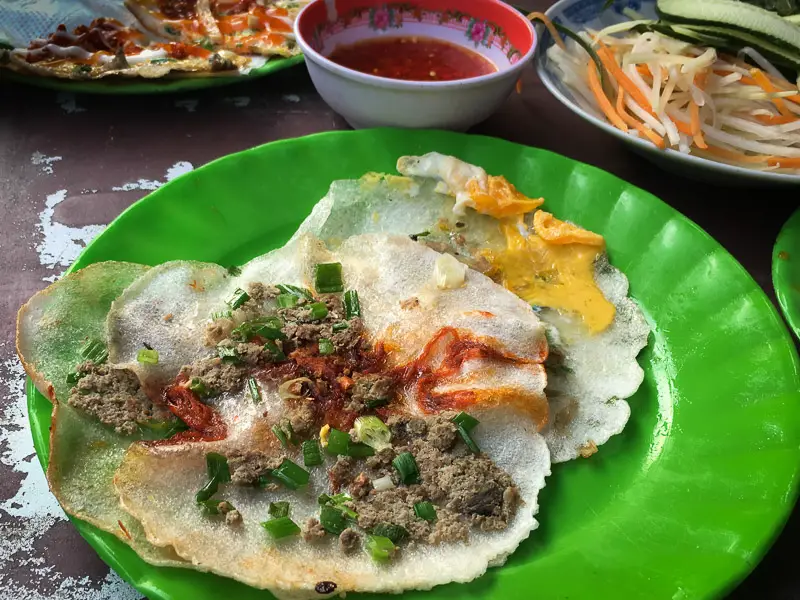
Desserts and Sweet Soups
Hue’s sweet tooth is best satisfied by diving into the world of Che Hue, the local varieties of sweet soups and desserts.
These are not just desserts; they are adventures in a bowl. Che Hem is a popular che restaurant serving a symphony of various local ingredients like mung beans, tapioca, and jelly, often bathed in a coconut milk base.
Walk a little further and discover Lotus Sweet Soup, known as “Che Sen.” It’s a delicate dessert made from lotus seeds, long been regarded for their flavor and supposed health benefits. Both desserts offer a refreshing respite, especially on warm, balmy days.
Dining in Hue
When you’re in Hue, immerse yourself in a culinary adventure that takes you through the heart of central Vietnamese cuisine, from top-notch local eateries to vibrant street food tours.
Best Restaurants in Hue
Hue is rich with dining options that cater to your quest for authentic flavors. Hang Me Me on Nguyen Du Street is not to be missed. It’s renowned for its traditional Vietnamese snacks. Try the banh beo — petite steamed rice cakes topped with dried shrimp and crisp pork skin.
For a memorable meal, Ba Do restaurant offers a cozy atmosphere and is famous for its mouth-watering bun bo Hue — a spicy beef noodle soup that’s a local staple. Meanwhile, Tai Phu stands out with its exceptional seafood dishes, ensuring a decadent aquatic indulgence.
Quan Cam is all about the local ambiance, serving a variety of Hue specialties, and don’t overlook Huyen Anh, known for its grilled meats that capture the essence of Hue’s rich culinary traditions.
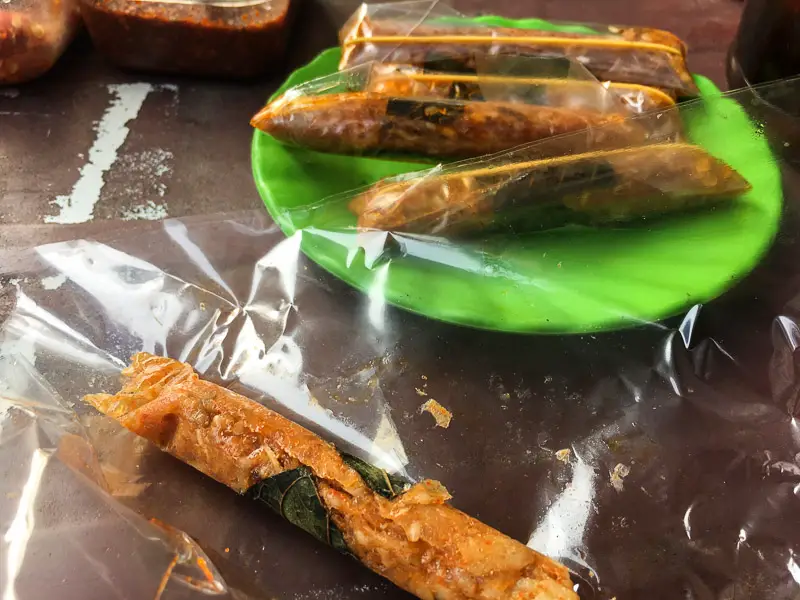
Street Food Tours
Diving into Hue’s street food scene is a sensory delight. Join a Hue Street Food Tour to explore the bustling city, where vendors entice you with an array of Hue’s best offerings.
From juicy nem lui (Hue lemongrass pork skewers with a peanut dipping sauce) to sweet and savory banh khoai (Hue crispy rice pancake), your taste buds are in for a treat.
Considered a must-do, the Food Tour is your gateway to discovering hidden gems and trying out delicacies you might not find on your own.
There is also join walking tour of the Citadel which is very popular.
Basics of Hue Foods
When you explore the culinary landscape of Hue, you dive into a world rich with aromatic herbs and a symphony of flavors that reflect the city’s imperial legacy. This section breaks down the essential ingredients and signature tastes that make Hue’s cuisine unforgettable.
Common Ingredients
In Hue’s dishes, you encounter a vibrant palette of ingredients. Rice, as the staple grain, often forms the base of your meal, either steamed plain, tossed into stir-fries, or ground to make delicate rice flour pancakes.
Proteins:
- Shrimp: Whether fresh or dried, shrimp add a punch of seafood flavor to many Hue specialties.
- Beef: Lovingly prepared in stews, stir-fries, and the famous bun bo Hue.
Vegetation:
- Onion: A common aromatic that offers a sweet and pungent undertone.
- Lemongrass: Chopped finely, this fragrant herb infuses your dish with citrus notes.
- Herbs: Fresh basil and mint are often added generously, giving you a refreshing bite.
- Ginger: Adds a warm, spicy kick to soups and marinades.
Condiments:
- Fish Sauce: The backbone of many sauces and dressings, delivering that umami depth.
These carefully chosen ingredients blend harmoniously to create the hallmark taste of Hue cuisine that you’ll savor in each bite.
Signature Flavors
Hue cuisine isn’t shy about using bold flavors. It’s known for its balance between spicy, tangy, and sweet.
Taste Profile:
- Spicy: The heat comes from chili peppers, which are either minced or used in sauces to give dishes a fiery depth that you’ll feel with each mouthful.
- Zesty: Lemongrass and ginger bring a zesty tang you can’t miss.
- Sweet and Salty: A balance often achieved with the judicious use of fish sauce and sometimes a hint of sugar to round out flavors.
The rich tapestry of flavors invites you to a sensory journey where every dish tells the story of Hue’s regal past through its bold and imaginative use of everyday ingredients.
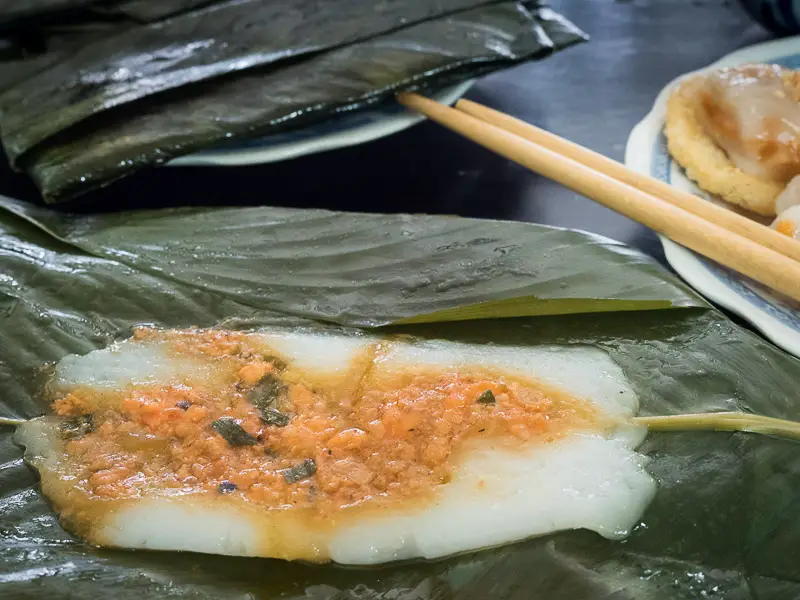
Culinary Techniques and Innovations
In Hue cuisine, you’ll encounter a range of cooking methods and modern interpretations of classic dishes that preserve their original flavor while presenting them in new ways.
Cooking Methods
Hue’s culinary scene is renowned for its steaming and simmering techniques. Traditional dishes often involve simmering ingredients slowly, infusing them with subtle flavors, and achieving a depth that tantalizes your palate. Here’s a simple breakdown of standard methods:
- Steaming: Perfect for making dishes like banh beo, where the batter made from tapioca flour becomes delightfully chewy.
- Simmering: Ideal for soups, this method allows salt and spices to permeate the broth, enhancing its healthful properties.
These techniques not only preserve the nutrients in the food, making it incredibly nutritious, but they also ensure that you experience Hue food as it’s meant to be—rich in flavor and history.
Modern Twists on Traditional Fare
Chefs in Hue are not afraid to experiment by adding contemporary touches to time-honored recipes. You might find dashes of creativity like:
- Inclusion of New Ingredients: A sprinkle of salt in a traditionally sweet dish might intrigue your taste buds with its salty-sweet complexity.
- Creative Presentation: While traditional flavors are maintained, modern plating can turn a meal into a work of art.
Through these innovations, Hue’s gastronomy remains vibrant and appealing to diners seeking both authenticity and a touch of newness in their meals.
Flavors and Condiments
Exploring Hue food, you’ll encounter a blend of tastes enhanced by distinct seasonings and fresh herbs. Whether it’s a tangy shrimp paste or a soothing royal tea, Hue’s culinary culture is a testament to its rich heritage.
Hue’s Unique Seasonings
You’ve probably heard about shrimp paste (mắm tôm), a staple in Hue’s cuisine. It’s pungent, salty, and packed with umami, transforming dishes with just a small amount. Shrimp paste adds depth to soups and is often served with rice and certain meats. Here’s how it’s typically incorporated:
- Soups: A teaspoon to enrich the broth
- Dips: Combined with chili and garlic for a robust sauce
Salt coffee is another unique tradition from Hue. Imagine a regular cup of coffee, then add a frothy crème topping mixed with salt. This contrast between the bitter coffee and the slightly salty cream creates a surprising flavor profile:
Coffee LayerCrème ToppingDark and robustCreamy with a salt edge
Herbs and Accompaniments
Fresh herbs and uplifting dishes with vibrant flavors and aromas are essential in Hue’s culinary scene. Accompaniments such as mint, perilla, and other leafy herbs are common. They’re presented on a side plate, so you can add to your liking and customize the freshness level in every bite.
Sweet flavors are not to be missed when you’re indulging in Hue’s desserts. They’re often infused in treats like sweet soups and cakes, where regional ingredients take the spotlight:
- Bean-based sweet soups: Subtle yet rich
- Sticky rice cakes: A perfect balance of sweet and savory
Pair this with a cup of royal tea, and you’re in for a sensorial treat. Once reserved for the imperial family, the tea complements the light sweetness and elevates your meal with its elegant aroma.
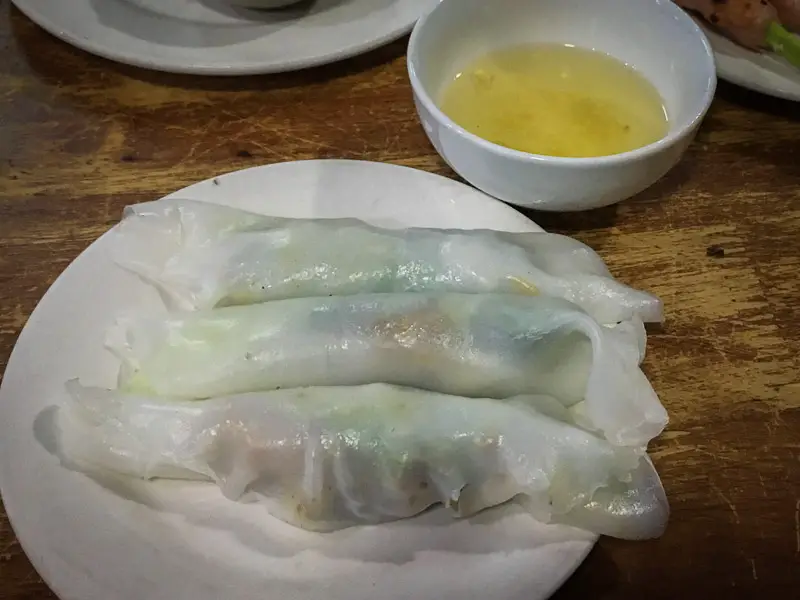
Food Culture in Hue
When you explore Hue, you’re diving into not just a place but a rich gastronomic tradition. Hue’s food culture is a vivid tapestry that reflects its historical significance in Central Vietnam and the everyday life of its local people.
Local Dining Customs
In Hue, meals are a communal affair. Lac Thien, a popular eatery, is a prime example where you can witness family-style dining.
People here often share multiple dishes, each one meticulously prepared, ranging from savory to spicy flavors.
A staple at these gatherings is the banana flower salad, a crunchy and refreshing dish combining the subtle bitterness of banana flower with the satisfying crunch of pork crackling.
Food as a Cultural Connector
For Hue’s residents, food is the medium through which culture is celebrated and preserved. Each dish tells a story, whether it’s about the royal cuisine from Hue’s imperial past or the humble beginnings of street food favorites.
As you sit down and enjoy a traditional Bun Bo Hue, a spicy beef noodle soup, you’re not just feeding your hunger; you’re getting a taste of Hue’s resilient spirit and rich culture.
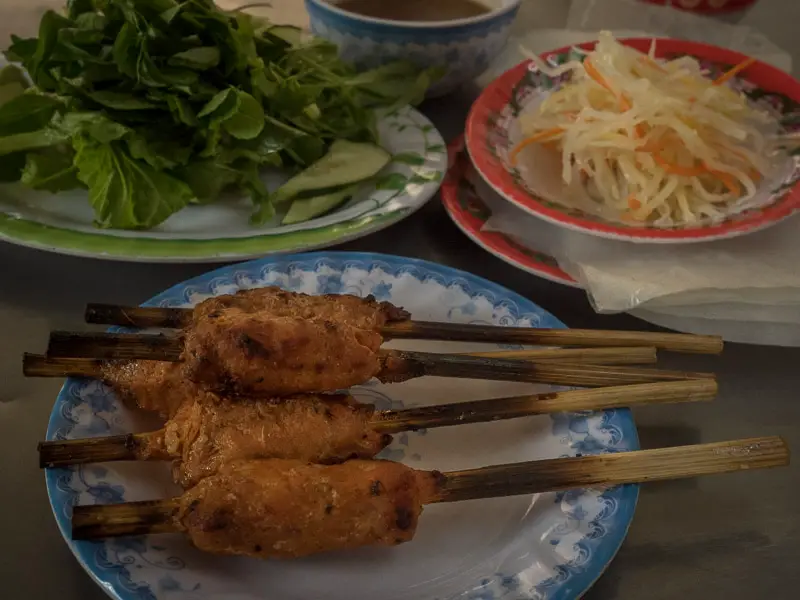
Hue Food Beyond the City
Hue’s culinary tradition holds a special allure, with dishes like bún bò Huế and cơm hến reaching beyond its ancient citadel walls to capture the hearts of food enthusiasts around the world.
Home-Style Cooking
When you step into a Vietnamese home anywhere across the globe, the warm, rich aroma of Lemongrass Pork might greet you, a testament to Hue’s influence.
It’s not rare to find a dish of Bánh Khoái—a crispy, savory pancake hailing from Hue—sizzling in the kitchen, ready to be wrapped in lettuce and herbs and dipped in savory-sweet sauce.
These homey dishes, once confined to the quaint streets and bustling markets around the Huế Citadel, are now recreated with love and nostalgia in domestic settings far from their origin.
- Lemongrass Pork (Thịt heo nướng sả)
- Key Ingredients: Pork, lemongrass, garlic, fish sauce, sugar
- Serving Suggestion: Often served with steamed rice or rice noodles and fresh herbs
- Bánh Khoái
- Preparation: Stuffed with shrimp, pork, bean sprouts, and served with peanut sauce
- Distinct Feature: Crispy turmeric-infused rice flour shell
Influence on Vietnamese Cuisine Abroad
As the Vietnamese diaspora established roots in new territories, so too did the savory and soulful flavors of Hue food. Bún bò Huế, for instance, has become a staple in Vietnamese restaurant menus worldwide.
The hearty and spicy beef broth, rice noodles, and herbed layers embody the very essence of Vietnamese comfort food. Meanwhile, Cơm Hến—a humble yet complex dish of rice with baby clams—exemplifies the depth and variety inherent in Hue cuisine, appealing to adventurous palates abroad.
Look around, and you’ll notice the subtle traces of Hue influencing various aspects of Vietnamese cuisine outside of Vietnam, honoring the culinary heritage of this former imperial city.
- Bún bò Huế
- Flavor Profile: Spicy, savory broth with lemongrass and shrimp paste
- Serving Tip: Best enjoyed topped with sliced beef, pork knuckle, and fresh herbs
- Cơm Hến
- Characteristics: A combination of rice, baby clams, crispy pork cracklings, peanuts, and aromatic herbs
- Cultural Significance: Representing the simplicity and elegance of Huế’s local fare
Drinks That Complement Hue Food
You can’t go wrong with traditional Vietnamese drinks for an authentic pairing. Salt Coffee is particularly noteworthy. This unique drink combines the bold flavors of Vietnamese coffee with a hint of saltiness in the cream, offsetting the richness of Hue’s spicy and savory dishes.
- Royal Tea: Enjoy this aromatic beverage like the kings once did in Hue. It’s a delicate tea that balances the heat from dishes like Bun Bo Hue with its light and floral notes.
Dietary Considerations
When exploring Hue cuisine, it’s essential to be aware of ingredients if you have specific dietary restrictions. Here’s what you need to know to enjoy the local food while adhering to your dietary needs.
Vegetarian and Vegan Options
In some Hue restaurants, vegetarian and vegan dishes may often contain fish sauce for flavor, which is a common ingredient in Vietnamese cuisine.
However, you can request dishes without fish sauce or seek out establishments that cater exclusively to plant-based diets. Typical vegetarian dishes might include stir-fried vegetables or tofu with rice, but make sure to ask if they use fish sauce.
For vegan options, bánh khoái can sometimes be made without eggs and animal products.
Allergy-Friendly Choices
Be aware that many Hue specialties, such as phở bò (beef noodle soup), are traditionally prepared with beef bones for the broth. You’ll want to avoid this dish if you’re allergic to beef.
Instead, look for rice-based dishes like cơm hến (clam rice) if shellfish is not a concern. If you have an allergy to pork, be cautious with soups and dishes that may include boiled beef, as pig blood or congealed pig blood is sometimes used for added richness.
For a safer choice, you might opt for simple rice dishes accompanied by vegetables and bean sprouts, which are less likely to contain allergens. Always communicate your allergies to the server to ensure your meal is safe for consumption.
Remember, Hue’s food scene has plenty to offer, and with a bit of careful navigation, you’ll find something delicious that accommodates your dietary considerations.
Hue Food in Contemporary Media
Hue cuisine has made its mark in various forms of media, giving you a taste of Vietnam’s imperial culinary heritage.
Appearance in Films and Books
Hue’s traditional dishes have graced both the silver screen and pages of popular literature, showcasing their unique flavors and cultural significance. For instance, in the film Indochine (1992), you might notice scenes where characters indulge in elaborately prepared Hue dishes, underlining the region’s rich gastronomy.
Books like The Songs of Sapa by Luke Nguyen immerse you in a vivid journey through Vietnam’s culinary landscape, with a special spotlight on the sophistication of Hue’s food.
If you found this post useful, you might enjoy one of these:
- Recipe for Vietnam’s National Dish – Pho Bo
- Com Tam: Vietnamese Broken Rice Recipe
- Bun Bo Nam Bo – Vietnamese Beef Noodle Salad
Hue cuisine is unique due to its perfect blend of sophistication and simplicity. Influenced by royal cuisine from the Nguyen Dynasty, it focuses on delicately presented dishes with complex flavors. Spices, especially chili, play a significant role, making Hue’s food spicier than other Vietnamese regions.
Some of the top dishes to try in Hue include Bun Bo Hue, Nem Lui (lemongrass skewers), Com Hen (clam rice), Banh Khoai (Vietnamese crepe), and Banh Beo (steamed rice cakes).
Hue is often referred to as the culinary capital of Vietnam because of its diverse food scene, influenced by its imperial heritage. The city offers many dishes, from street food to sophisticated royal cuisine.
Vegetarian-friendly dishes in Hue include Banh Beo (steamed rice cakes), Banh Khoai (Vietnamese crepe), and various types of Chay (vegetarian) dishes inspired by Buddhist traditions.

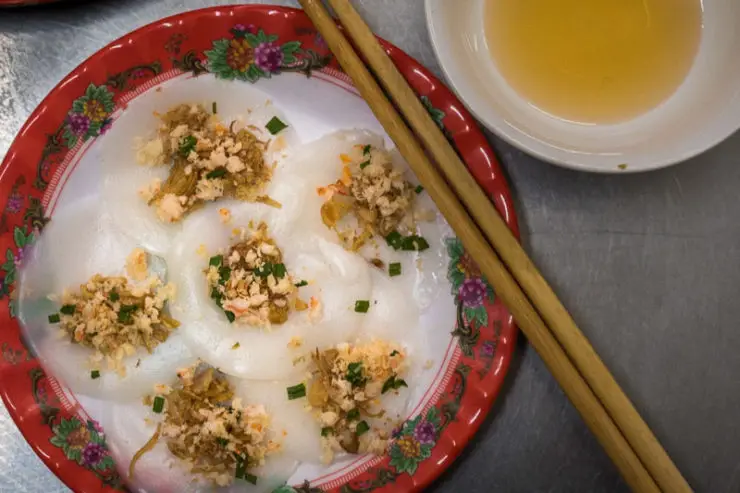
All of these seem delicious 🙂
Hi Kathy, yes the food in Hue is quite amazing. Wish I had longer there…..
Thanks for the comment.